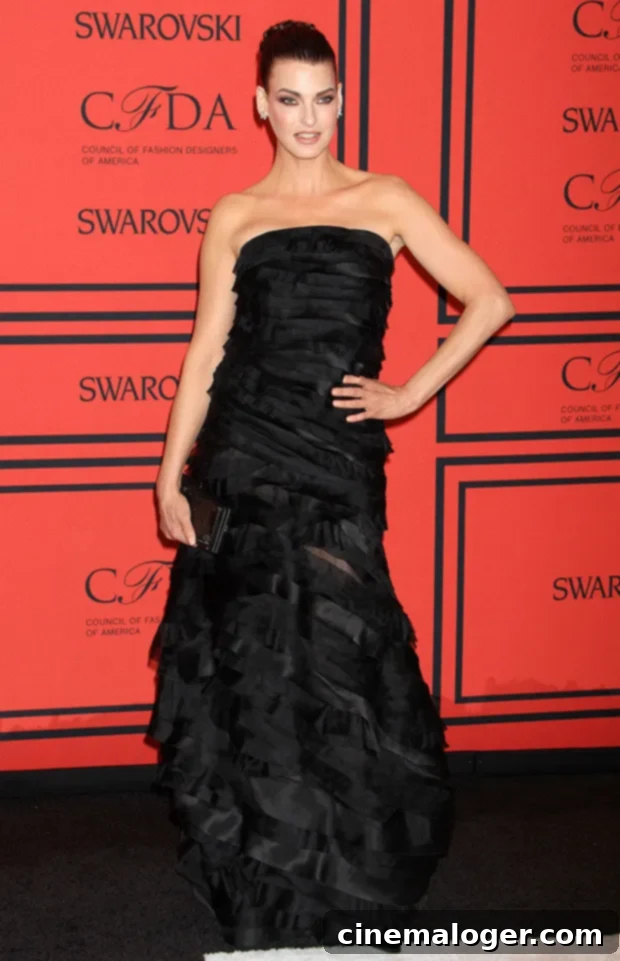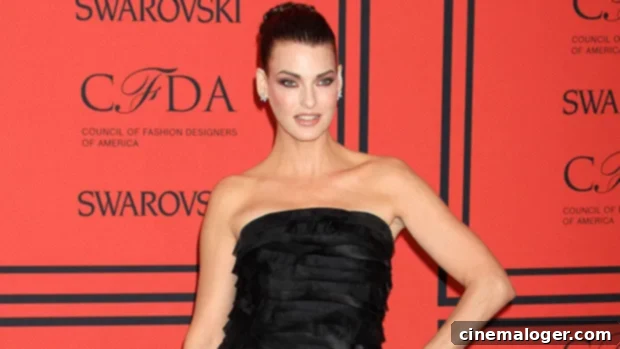Linda Evangelista’s CoolSculpting Nightmare: The Supermodel’s Battle with Permanent Deformity and PAH
Supermodel Linda Evangelista, a name synonymous with beauty and fashion in the 1990s, has bravely stepped forward to share her harrowing experience with a cosmetic procedure known as CoolSculpting. At 56 years old, Evangelista revealed that the “fat-freezing” treatment, undertaken between August 2015 and February 2016, left her “permanently deformed” and “brutally disfigured.” Her candid disclosure, accompanied by the first public photos of her altered appearance in years, sent shockwaves through the fashion world and beyond, highlighting the potentially devastating risks associated with aesthetic procedures, even those marketed as safe and non-invasive.
For six years, Linda Evangelista lived a life shrouded in secrecy and shame, retreating from the public eye that once celebrated her iconic image. In a revealing interview with People, she articulated the profound emotional toll, stating, “I can’t live like this anymore, in hiding and shame. I just couldn’t live in this pain any longer. I’m willing to finally speak.” Her courage to speak out stems from a diagnosis of Paradoxical Adipose Hyperplasia (PAH), received in June 2016. This rare and devastating side effect emerged after she noticed distressing bulges in areas of her body that were specifically targeted for fat reduction by the CoolSculpting procedure. Instead of shrinking, her fat cells had expanded and hardened, defying the very promise of the treatment.

Upon consulting her doctor, Evangelista received a grim prognosis. “He told me that no amount of dieting and no amount of exercise was ever going to fix it,” she recounted, underlining the irreversible nature of the damage. While CoolSculpting is an FDA-cleared procedure often presented as a non-surgical alternative to liposuction, PAH remains a rare side effect, affecting less than one percent of patients. A representative for CoolSculpting acknowledged to People that side effects, including PAH, are “well-documented in the CoolSculpting information for patients and health care providers.” However, for Evangelista, this documentation offers little solace, as it did not prevent her life-altering experience. The discrepancy between the marketing of “fat-freezing” as a simple solution and the potential for such severe complications raises significant questions about patient awareness and informed consent in the booming cosmetic industry.
CoolSculpting, scientifically known as cryolipolysis, is a popular non-invasive cosmetic procedure designed to reduce localized pockets of fat. It works by freezing fat cells, causing them to die and be naturally eliminated by the body over time. Marketed as a safe, effective, and convenient alternative to surgical procedures like liposuction, it appeals to individuals seeking to sculpt their bodies without downtime or invasive surgery. The promise is tempting: a slimmer, more contoured physique achieved through a series of office visits. However, Linda Evangelista’s case serves as a stark reminder that even FDA-cleared procedures carry inherent risks. Paradoxical Adipose Hyperplasia (PAH) is a particularly distressing complication because, instead of shrinking, the treated fat cells inexplicably harden and expand, forming distinct, often painful, bulges that are resistant to diet and exercise. This phenomenon tragically reverses the intended effect of the procedure, leaving patients with worse body contours than before and profound psychological distress. Understanding the full spectrum of potential outcomes, however rare, is crucial for anyone considering such aesthetic interventions.
View this post on InstagramA post shared by Linda Evangelista (@lindaevangelista)
Desperate to reverse the effects of PAH, Linda Evangelista underwent two rigorous full-body liposuction surgeries. The first procedure took place in June 2016, followed by a second attempt in July 2017. Both times, she meticulously followed her doctors’ instructions through grueling eight-week recovery periods, holding onto hope for a return to her former self. However, her efforts were in vain. Evangelista painfully recalled, “It wasn’t even a little bit better.” The PAH persisted, manifesting as “protrusions” that were not only visibly disfiguring but also hard to the touch and intensely uncomfortable. The physical discomfort extended to daily life, with the bulges causing severe chafing, “to the point of almost bleeding” if she walked without a girdle in a dress. This constant physical pain, coupled with the emotional anguish, led to a profound disconnect from her own reflection. “I don’t look in the mirror. It doesn’t look like me,” she confessed, illustrating the complete erosion of her self-image and identity.
Linda Evangelista’s decision to share her story publicly was inextricably linked to the lawsuit she filed in 2021 against Zeltiq Aesthetics Inc., the parent company behind CoolSculpting. She sought $50 million in damages, asserting that the catastrophic outcome of the fat-freezing procedure had rendered her unable to work since undergoing the treatment. Beyond the financial implications, the lawsuit represents a pivotal step in her journey to reclaim her narrative and find a measure of peace. In September, Evangelista powerfully articulated the profound impact PAH had on her life: “PAH has not only destroyed my livelihood, it has sent me into a cycle of deep depression, profound sadness and the lowest depths of self-loathing. In the process, I have become a recluse. With this lawsuit, I am moving forward to rid myself of shame and going public with my story.” Her legal battle is not merely about compensation but about accountability, transparency, and shedding light on a silent struggle faced by some patients of cosmetic procedures.
The bravery exhibited by Linda Evangelista in sharing her deeply personal and painful experience has garnered widespread support, notably from her longtime friend and fellow supermodel, Naomi Campbell. Earlier this week, Campbell publicly praised Evangelista, telling British Vogue, “She’s a strong woman and I think she’s very brave. It takes a lot of courage to come out and speak her truth. I stand by her absolutely.” This outpouring of solidarity from within the highly scrutinized and image-conscious fashion industry underscores the significance of Evangelista’s revelation. Her story transcends a personal tragedy; it ignites a crucial conversation about the pressures to conform to beauty standards, the ethical considerations surrounding cosmetic procedures, and the absolute necessity for comprehensive patient education regarding potential risks. Evangelista’s courageous stand serves as a powerful testament to the importance of speaking one’s truth, not only for personal healing but also to advocate for greater transparency and safety within the cosmetic and beauty landscape for all.
Linda Evangelista’s journey from a celebrated supermodel to a recluse battling permanent deformity offers a poignant and cautionary tale. Her experience with Paradoxical Adipose Hyperplasia (PAH) after an FDA-cleared CoolSculpting procedure underscores the critical importance of understanding all potential risks, no matter how rare, before undergoing any cosmetic treatment. By breaking her six-year silence and bravely sharing her story and image with the world, Evangelista has not only sought to reclaim her own life from the grip of shame and depression but has also sparked a vital dialogue. Her lawsuit against Zeltiq Aesthetics Inc. aims to hold the company accountable and ensure greater transparency for future patients. Ultimately, Linda Evangelista’s courage stands as a powerful reminder that true beauty encompasses strength, resilience, and the unwavering pursuit of truth, pushing us to critically examine the relentless pursuit of perfection and the realities of the modern beauty industry.
